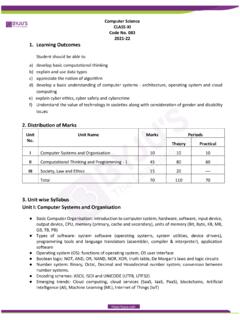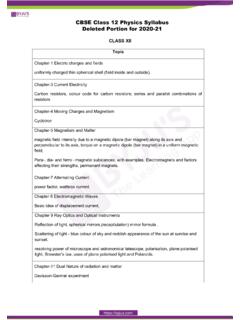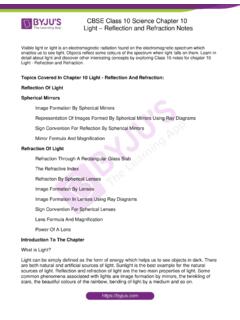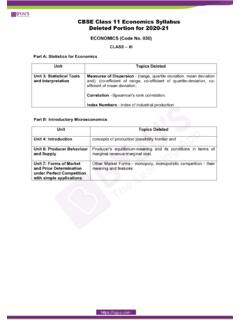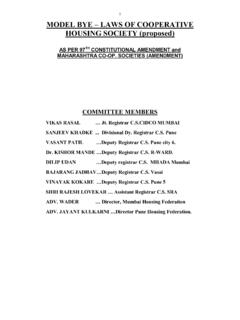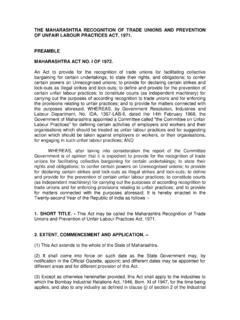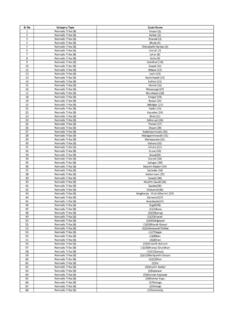Transcription of Maharashtra Board Class 5 EVS Textbook - Byju's
1 Education Department s Sanction Number :Pra Shi Sa/2014-15/H/Bhasha/Manjuri/D-505/727 Dated : State Bureau of TextbookProduction and Curriculum Research, Pune.(Part One)STANDARD FIVEF irst Edition : 2015 The Maharashtra State Bureau of Textbook Production and Curriculum Research reserves all rights relating to the book. No part of this book should be reproduced without the written permission of the Director, Maharashtra State Bureau of Textbook Production and Curriculum Research, Balbharati , Senapati Bapat Marg, Pune 411 Subject Committee : Dr Ranjan Kelkar, Chairman Smt. Mrinalini Desai, Member Dr Dilip R. Patil, Member Shri. Atul Deulgaonkar, Member Dr Bal Phondke, Member Shri. R. A. Patole, Member - SecretaryCivics Subject Committee : Dr Yashwant Sumant, Chairman Dr Mohan Kashikar, Member Dr Shailendra Devlankar, Member Dr Uttara Sahasrabuddhe, Member Shri. Arun Thakur, Member Shri. Vaijanath Kale, Member Shri. Mogal Jadhav, Member-Secretary Cartographer : Shri.
2 Ravikiran JadhavCover : Smt. Anuradha DangareIllustrations : Shri. Nilesh Jadhav, Shri. Deepak Sankpal, Shri. Mukim Tamboli, Shri. Sanjay Shitole, Shri. Vivekanand Patil, Shri. Amit Jalwi, Shri. Pratik Kate, Shri. Rupesh Gharat, Shri. Manoj Kamble, Shri. Sameer Dhurade (Space related photographs) Typesetting : DTP Section, Textbook Bureau, PunePaper : Print Order :Printer :Shri. R. A. PatoleSpecial Officer for ScienceSmt. Vinita TamneSubject Assistant, ScienceShri. Mogal JadhavSpecial Officer for History and CivicsSmt. Varsha KambleSubject Assistant, History and CivicsShri. Ravikiran JadhavSpecial Officer for GeographyProductionShri. Sachchitanand AphaleChief Production OfficerCo-ordinationShri. Vivek Uttam Gosavi, ControllerMaharashtra State Textbook Bureau, Prabhadevi, Mumbai - 400 :Smt. Mrinalini DesaiMs. Neena AbhyankarScrutiny : Dr JogCo-ordination : Dhanavanti HardikarAcademic Secretary for LanguagesSantosh PawarSubject Assistant, EnglishPublisherShri.
3 Vinod GawdeProduction OfficerMrs. Mitali ShitapProduction AssistantGeography Subject Committee : Dr N. J. Pawar, Chairman Dr Medha Khole, Member Dr Inamdar Irfan Ajiz, Member Shri. Abhijit Ghorpade, Member Shri. Sushilkumar Tirthkar, Member Smt. Kalpana Mane, Member Shri. Ravikiran Jadhav, Member-SecretaryMaharashtra State Bureau of Textbook Production and Curriculum Research, Pune 411 004. PreambleThe Constitution of India WE, THE PEOPLE OF INDIA, having solemnly resolved to constitute India into a SOVEREIGN SOCIALIST SECULAR DEMOCRATIC REPUBLIC and to secure to all its citizens: JUSTICE, social, economic and political; LIBERTY of thought, expression, belief, faith and worship; EQUALITY of status and of opportunity; and to promote among them all FRATERNITY assuring the dignity of the individual and the unity and integrity of the Nation; IN OUR CONSTITUENT ASSEMBLY this twenty-sixth day of November, 1949, do HEREBY ADOPT, ENACT AND GIVE TO OURSELVES THIS ANT The following foot notes are applicable :-1.
4 Government of India, Copyright The responsibility for the correctness of internal details rests with the The territorial waters of India extend into sea to a distance of twelve nautical miles measured from the appropriate base line. 4. The administrative headquarters of Chandigarh, Haryana and Punjab are at The interstate boundaries amongst Arunachal Pradesh, Assam and Meghalaya shown on this map are as interpreted from the North-Eastern Areas (Reorganisation) , but have yet to be The external boundaries and coastlines of India agree wih the Record/Master Copy certified by Survey of India. 7. The state boundaries between Uttarakhand and Uttar Pradesh, Bihar and Jharkhand and Chhattisgarh and Madhya Pradesh have not been verified by the Governments The spellings of names in this map, have been taken from various Panel : Smt. Sucheta Phadke Shri. V. D. Lale Smt. Sandhya Lahare Shri. Shailesh Gandhe Shri. Abhay Yavalkar Shri. Rajabhau Dhepe Dr Shamin Padalkar Shri.
5 Vinod Tembe Dr Jaysingrao Deshmukh Dr Lalit Kshirsagar Dr Jayashri Ramdas Dr Manasi Rajadhyaksh Shri. Sadashiv Shinde Shri. Baba Sutar Shri. Arvind GuptaGeography Panel : Shri. Bhaidas Somvanshi Shri. Vikas Jhade Shri. Tikaram Sangrame Shri. Gajanan Suryavanshi Shri. Padmakar P. Kulkarni Shri. Samansing Bhil Shri. Vishal Andhalkar Smt. Rafat Sayyad Shri. Gajanan Mankar Shri. Vilas Jamdhade Shri. Gourishankar Khobre Shri. Pundalik Nalawade Shri. Prakash Shinde Shri. Sunil More Smt. Aparna Phadke Dr Shrikrishna Gaikwad Shri. Abhijit Dod Dr Vijay Bhagat Smt. Ranjana Shinde Dr Smita GandhiCivics Panel : Prof. Sadhana Kulkarni Dr Chaitra Redkar Dr Shrikant Paranjape Dr Bal Kamble Prof. Fakruddin Bennur Prof. Nagesh Kadam Shri. Madhukar Narde Shri. Vijaychandra ThatteFor Teachers / Parents Consider the following points while teaching this Textbook of Standard Five : The boxes Do you know ? and Use your brain power !
6 Have been included to awaken the students curiosity, and to encourage them to think beyond the Textbook . Students are expected to learn through their own experiences, the information sought under Can you tell ? , Try this , and Use your brain power ! Teachers / Parents should provide the guidance necessary for that. At the end of every lesson, there is a box with the title What we have learnt - . It sums up the information that the children obtain from the lesson. Children should form the habit of thinking independently and expressing their opinion in a responsible manner. The information and tasks given under headings like Read and discuss , Think! , Speak and write , etc. will help them form this habit. The Primary Education Curriculum 2012 was prepared in the State of Maharashtra following the Right of Children to Free and Compulsory Education Act, 2009 , the National Curriculum Framework 2005 and the Maharashtra State Curriculum Framework 2010.
7 The Textbook Bureau has launched a new series of textbooks based on this syllabus approved by the State Government from the academic year 2013-2014. We are happy to place this Textbook Environmental Studies (Part One) Standard Five in this series in your hands. Our approach while designing this Textbook was that the entire teaching-learning process should be child-centred, emphasis should be given on active learning and constructivism and at the end of Primary Education the students should have attained the desired competencies and that the process of education should become enjoyable and interesting. There are many colourful illustrations and maps in this Textbook . Some activities have been included in this Textbook under the titles Can you tell ? , Try this. , Use your brain power ! . They will help the students to understand the concepts introduced in the lossons and will also reinforce them.
8 The Textbook will motivate the children to observe their environment. Conscious efforts have been made to impart values which are relevant today in the context of this Textbook . Variety in the exercises will help the children to revise and retain the concepts in the lessons and will motivate them to study on their own. They will also help the teacher with continuous, comprehensive evaluation. This Textbook introduces the children to their natural, social and cultural environment. It attempts to develop the students skills of problem solving and application and a healthy attitude towards the environment. The language of presentation used in this book is simple. The topics have been presented in an inter-disciplinary manner without forming compartments of science, geography and civics. It may lead to an approach that looks at several dimensions of an issue or topic simultaneously. We have tried to keep in mind the diverse experiences of all the children in Maharashtra while writing the book.
9 This book was scrutinized by teachers from all parts of the State, by educationists, experts and members of the syllabus committee to make it as flawless and useful as possible. Their comments and suggestions have been duly considered by the Subject Committees while finalising the book. The members of Science, Geography and Civics Subject Committees, Panel members, quality reviewers and artists have taken great pains to prepare this book. The Bureau is thankful to all of them. We hope that this book will receive a warm welcome from students, teachers and parents. PrefacePune Date : March 5, 2015 (C. R. Borkar)DirectorMaharashtra State Bureau of Textbook Production and Curriculum Research, Chapters Page Our Earth and Our Solar System ..12. Motions of the Earth ..63. The Earth and its Living World ..114. Environmental Balance ..185. Family Values ..246. Rules Are for Everyone..287. Let us Solve our own Problems.
10 328. Public Facilities and My School ..359. Maps - our Companions ..3910. Getting to Know India ..4411. Our Home and Environment ..5112. Food for All ..5813. Methods of Preserving Food ..6414. Transport ..6815. Communication and Mass Media ..7316. Water ..7717. Clothes - our Necessity ..8218. The Environment and Us ..8919. Constituents of Food ..9620. Our Emotional World ..10321. Busy at Work - our Internal Organs ..10722. Growth and Personality Development ..11523. Infectious Diseases and how to Prevent them ..12124. Substances, Objects and Energy ..12725. Community Health and Hygiene ..1331 When we look up from an open ground, we see the sky. In a clear night sky we can see many stars. They are very far away from the earth. Some stars are prominent while some are tiny and faint. If we look at them carefully, we find that many of them twinkle, but some do not. The sun and the moon are comparatively close to the earth.
